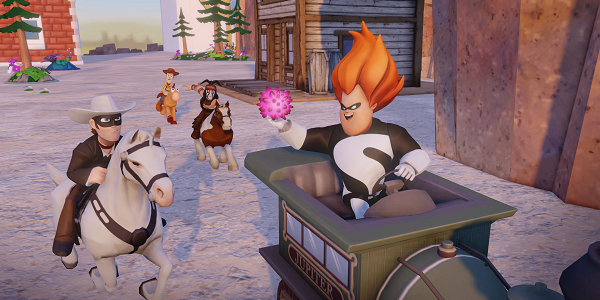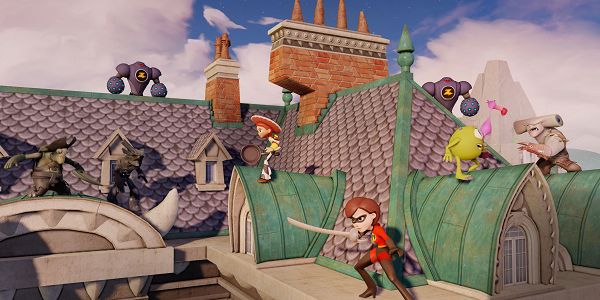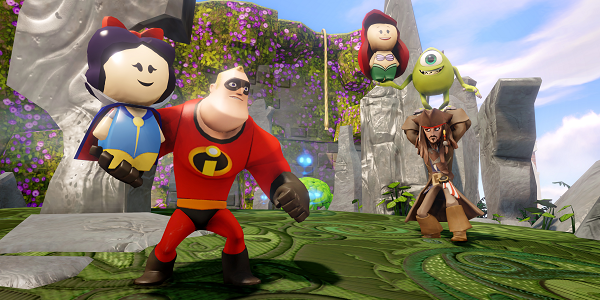Disney Infinity is a bold undertaking. Working off of Activision’s popular Skylanders mold, Disney is integrating figurines of several characters from across the company’s properties into gameplay by allowing players to scan them into the Infinity‘s numerous worlds. While each of these worlds — known in the game as Play Sets — will feature its own setting, story, and play mechanics, it’s the creative Toy Box mode that was the game’s biggest of challenges.
This was what I was able to get my hands on during a special pre-E3 event for the ambitious title. Toy Box is essentially a world-building creative suite. Anything from textures and terrain to race tracks and giant basketballs can be tweaked or inserted into the Toy Box map. This means that players can make almost any type of level they want, with multiple different types of gameplay available in one location.
In my time with game, I was able to experience a race, 2D platforming, combat, player vs. player bashing, and even a sort of sporting event. Each were, for the most part, enjoyable endeavors. What most of these had in common was an object that serves as the linchpin for a large portion of actions in Toy Box mode, further enhancing the experience: triggers.

The name is rather self-explanatory. I’d place a trigger on the ground, then create an object for it to trigger. During my demo, I placed some firework cannons a short distance from the trigger’s location. Then, through the use of tethering, I programmed the cannons to fire a grand finale when someone walked onto the trigger. This act is also crucial for spawning objects, for changing camera views, and for numerous other programming options. My race had a trigger that gave birth to a massive basketball that would roll down a bridge into my path, forcing me to perform some evasive maneuvers. Spawning can also work for enemies if I wanted to leave a surprise or two laying around for my friends to stumble upon.
To insert these triggers and any other object — known in Disney Infinity as toys — I simply had to press the select button and up came one of two menus. One had a massive list in a box that took up the middle of the screen, while the second had a single-row list that could be scrolled through with the trigger and shoulder buttons (R and L for PS3). Disney told me that the final product would only feature one of these menus. I hope it’s the latter, as it takes up far less screen space and is more aesthetically pleasing.
Once finding the object I wanted, I could then select it and move it around the world until I found the appropriate location. If I didn’t approve of my previous placement or the toy’s properties if tethered to a trigger, I could equip my character with the game’s wand and use it to select and edit the toy. This also helps to remove objects that have served their purpose and are now just laying in the way and taking up space, like the race’s basketball.
This type of management of what is or isn’t in the world is important, as the Toy Box only has a set amount of memory that it can dedicate to the world. This is presented visually by a meter on the left-hand side of the HUD and will fill up as you add more things to the Toy Box. The space, however, isn’t too limiting; the world I ran around in had a race track, sports arena, platformer section, and a few player-created hills. All of that only amounted to about a quarter to a third of the Toy Box’s total memory.

When I grew tired of creating objects, I decided to give the game’s simplistic but entertaining combat a try. After finding another player fighting some adversarial toys, I decided to lend him a hand. Melee was controlled by repeatedly tapping the Y button repeatedly for a combo, and I could use either bare fists or melee weapon, which included a sword and lawn flamingo. Ranged guns can be fired with the right trigger and aimed with the left trigger and can serve a variety of purposes. The two examples I was presented were the basic damage-dealing energy gun and a goo gun that can change the recipient’s size for a short duration.
Upon dispatching those foes, I quickly decided to try out some player vs. player… without telling my recent buddy. Each character has a health bar, and once it’s depleted the character will break apart and then respawn in the same location a few seconds later. It’s fun, but being able to knock down enemies at the end of a combo can cause some unfair, merciless beat downs. I felt sympathy for my former pal when I tested this out to the fullest on him.
This all served as but a taste of the seemingly countless shenanigans that can ensue with Disney Infinity‘s Toy Box and four-player multiplayer. The game’s various purchasable characters, buffs, and vehicles taken and inspired from all across the Disney universe will only add to the possibilities. The game is shaping up to be a source of hours upon hours of creative entertainment for gamers and Disney fans alike.


















